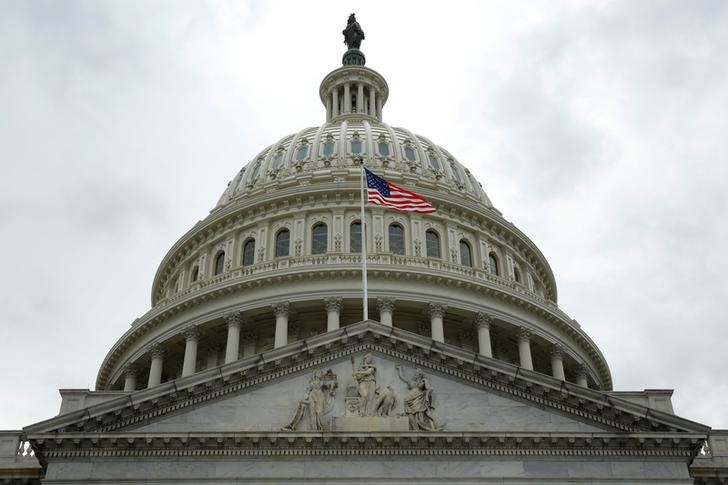(Bloomberg) -- America’s leaders face an urgent set of decisions on whether to extend history’s biggest rescue effort -- or let parts of it lapse.
The government approved more than $2 trillion of extra spending after the coronavirus brought swaths of industry and commerce to a sudden halt. Some measures targeted those who took the biggest hit, like the unemployed and small business. Others were across-the-board, reaching every corner of the economy.
But these programs are due to run out in the coming weeks and months. Each expiration date will test the still-fragile U.S. recovery -- unless policy makers opt to keep crisis supports in place.
These kind of cutoff dates, when past decisions dictate a big change in net government spending unless further action is taken, are sometimes known as “fiscal cliffs.” They have a history of roiling markets, as politicians take the debate to the brink.
The Trump administration wants another relief bill, with a price tag not exceeding $1 trillion, before lawmakers head out of town for summer recess in early August. The Democrat-controlled House already approved additional measures worth $3.5 trillion, but Republicans who have a Senate majority oppose many of them.
Here are some of the looming deadlines, and the numbers involved.
Unemployment Insurance
The federal government added $600 a week to state-provided jobless benefits under the CARES Act, the main coronavirus relief measure passed by Congress in March. Those extra payments, which helped plug a hole in household finances, are due to run out in the final week of July.
What to do next has turned into a fierce political fight. With unemployment still at levels not seen since the Great Depression era, the Treasury has been disbursing the benefits at a record pace of about $100 billion a month since May. Republicans are concerned that the payments could deter people from resuming their jobs, and want some of the stimulus channeled into a “back-to-work bonus” instead.
Big Business
The government handed $25 billion in payroll support to America’s passenger airlines to help them retain staff through the end of September, as well as offering loans worth a similar amount.
The carriers have already signaled that layoffs will likely start as soon as that program expires. This month, United Airlines told some 36,000 employees -- about 45% of the U.S. workforce -- that their jobs will be at risk starting in October.
So far the trade group for major carriers, Airlines for America, says it isn’t seeking additional funding, although labor unions in the industry have called for an extension of the aid programs.
Small Business
The deadline to apply for more than $132 billion still available in the small-business relief program has been extended until Aug. 8.
Congress also took action to smooth the path for companies that already borrowed under the program. They were originally supposed to spend the money within eight weeks -- mostly on payroll -- to qualify for forgiveness of the loans. That was stretched out to as long as 24 weeks.
Student Loans
The CARES Act froze repayments through the end of September on student loans owned by the federal government, which make up about three-quarters of the $1.54 trillion total. Americans will likely save about $7 billion a month while the measure is in place.
When those bills start arriving again in October, there’s a risk that millions won’t be able to pay. Even in 2019, with unemployment at half-century lows, about 11% of student debt was delinquent -- and the New York Fed says that the effective rate is twice as high, since half of the loans weren’t currently due for payment anyway.
Mortgage Borrowers
The CARES Act set up a forbearance program that covered federally insured mortgages. The total payments on loans that qualify for the plan would be about $55 billion a month, the New York Fed estimates.
The Mortgage Bankers Association said this week that 8.2% of loan balances, owed by an estimated 4.1 million homeowners, were in forbearance.
Renters
The CARES Act imposed a freeze on evictions through July 25 for multifamily properties whose mortgages are financed by federal agencies like Fannie Mae. Owners who benefited from mortgage relief are barred from evicting tenants after that date too, for as long as their loans are in forbearance. And the Federal Housing Finance Agency has extended safeguards through at least Aug. 31 for tenants of single-family homes with federally insured mortgages.
All told, the federal measures cover about 12.3 million of the country’s 43.8 million rental homes, according to the Urban Institute. A patchwork of measures by states and cities also offered protection to renters. Some of those have already run out, and others are about to, according to Princeton University’s Eviction Lab.
About one-third of tenants who responded to the Census Bureau’s Household Pulse survey during the first week of July said they had little or no confidence that they could make next month’s payment.
Taxes
Americans were allowed until this week to file their income-tax returns, after the federal deadline was delayed by three months to July 15.
Two other measures will be in place through Dec. 31. Payroll-tax deferral allows businesses to defer their portion of the taxes and repay them in 2021 and 2022. Companies can also claim the Employee Retention Tax Credit through the end of the year. It’s worth as much as $5,000 per employee, and there’s bipartisan support in Congress for increasing that sum in the next stimulus package.
